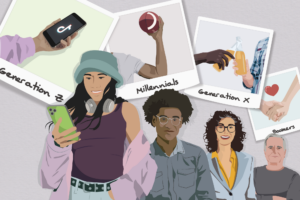Newsletter June 29, 2023
Why are Young Voters So Down on Joe Biden?

Starting in about 2004, young voters emerged as a consistently reliable Democratic voting bloc. Barack Obama enjoyed a massive advantage among young voters in the 2008 election, besting 72-year-old John McCain by a 34-point margin. Even as public support waned for Obama during his first term, young adults remained steadfast in their support. Young voters were critical for Biden’s win in 2020 as well. Six in ten young adults voted for Biden in 2020, while only 36 percent supported Trump.
Despite this substantial margin, there were early signs that young voters were not sold on Biden. A survey we conducted in the summer of 2020 found that nearly one in three young adults said the decision about who to support in the coming presidential election would be difficult. Older voters were far less likely to say deciding who to support in the 2020 election would be a difficult choice.
I’m hardly the first person to notice Biden’s troubles with young voters. Last year, Vox’s Christian Paz and FiveThirtyEight’s Geoffrey Skelley, noted that young adults have become increasingly frustrated with Biden. Both are worth reading, but new research presents additional arguments we might consider.
Are Young Voters Looking for Youthful Candidates?
One obvious explanation for Biden’s trouble with young voters is that he is old. Very old. Polls have shown Biden’s age is an issue for voters, but it’s not clear that younger voters are especially concerned about it. In fact, researchers show that even young voters tend to prefer somewhat older, more experienced candidates or find minor effects of age on youth voting trends. Survey experiments find weak support for age as a significant determinant of candidate preference.
This is supported by previous election results as well. Barack Obama was only 47 years old when he was elected president, and his historic candidacy garnered widespread support among Millennials. Even a decade later, Millennials still view Obama favorably. But Obama was not just young, he was new. And that was probably more important than his age. Bill Clinton was comparatively young when he first ran for president at 46 years old—he was and remains the third youngest ever. His vice president, Tennessee Senator Al Gore, was also relatively young. But Clinton failed to attract widespread support among younger voters. In fact, Clinton’s largest advantage over incumbent president George H. W. Bush came from seniors. According to exit polls, 43 percent of young adults supported Clinton in the 1992 election compared to 34 percent who backed Bush. Third-party candidate Ross Perot captured an impressive 22 percent of the youth vote.
A Preference for Outsiders
Historically, young adults have expressed a strong independent streak, but young Americans today are even more likely to identify as politically independent, even as their political views have shifted left. Today, more than half (52 percent) of young adults are political independents, a 10-point increase over the last two decades.
In 2021, Pew’s long-running political typology study identified a group of young, left-leaning disaffected Democrats they called the “Outside Left.” Pew describes them this way: “Holding liberal views on most issues and overwhelmingly voting Democratic, they aren’t particularly enamored with the Democratic Party—though they have deeply negative views of the GOP.” They overwhelmingly favor free college tuition, but remain skeptical of government.
These voters are less invested in the existing political order—which many view as being flawed or broken—and are less interested in candidates who seek to uphold it. This helps explain why young voters swarmed to Independent-Socialist Bernie Sanders who regularly critiqued the unfairness of the economic and political systems and attacked Democrats and Republicans alike. In fact, Sanders remains the top choice of young Democrats in 2024—more than twice as many say they would prefer the Vermont Senator to be the 2024 nominee than Biden or Vice President Kamala Harris.
Biden, who was first elected to the US Senate in 1972, has been around a long time. He has been described as a “creature of the Senate”, and maintains a deep and abiding respect for the institution. None of this is going to endear him to young voters.
A Lack of Progress
Rightly or wrongly, Joe Biden is viewed by the public as something of a mainstream or moderate Democrat. He sold himself as something of a placeholder candidate in 2020, but he has hardly governed that way.
The fact is, Biden has as strong a legislative record as any recent Democratic president, if not stronger. He’s made progress on issues, such as climate change, the cost of higher education, and guns, that are priorities for young people. But much of this has gone unnoticed or unappreciated. We found that young people give Biden extremely low marks for his legislative accomplishments. In the report, we note:
Only 27 percent of young adults say Biden has accomplished a good amount or a great deal during his time in office. By contrast, more than four in 10 seniors (45 percent) say Biden has made some significant accomplishments.
It’s probable that young people are less aware of these successes—polls have shown that—but I think there’s more to it. In an interview with CNN, Noah Lumbantobing, of March for Our Lives, captured the problem many young voters have with the president: “Biden has done good things. He hasn’t done enough in terms of using his bully pulpit.”
I’m not so sure this is the issue. I think more than anything, the problem young people have with Biden is what he represents: a political system dominated by America’s oldest generations that in turn preferences the interests of America's oldest voters. Nearly half of all members of Congress are Baby Boomers, though they comprise only 21 percent of the public overall. America's political leaders have never been so old, and young people have noticed. A recent Data for Progress poll finds that 70 percent of young Americans believe their generation is underrepresented in Congress. They are.
Looking Ahead
What does this mean for the 2024 election? A New York Times/Siena College poll suggests that young voters, fed up with current political leadership, might sit out the election altogether. As Maya King and Jonathan Weisman write in that article, “Of all age groups, young voters were most likely to say they wouldn’t vote for either Mr. Biden or Mr. Trump in a hypothetical 2024 rematch.” I’m doubtful that we’ll witness mass abstentions in 2024. Most young voters loath the two leading contenders for the GOP nomination. In fact, 44-year-old Ron DeSantis is viewed more negatively among young people than Trump. That’s probably sufficient motivation.
Looking beyond the next election, things are less certain. If you’re a regular reader of Storylines, you know that surveys show a growing division in the politics of young men and women. Young men and women have similar (and mostly negative) views of Biden, but young women have a far more positive opinion of the Democratic Party. Only 28 percent of young men view the Democratic Party favorably, compared to 42 percent of young women. I’m not sure young men see either party as advocating for their interests. If you’re trying to understand why people vote the way they do, there’s not much more to it than this.








